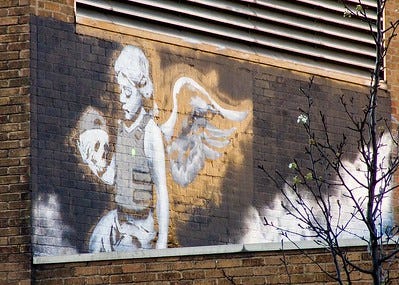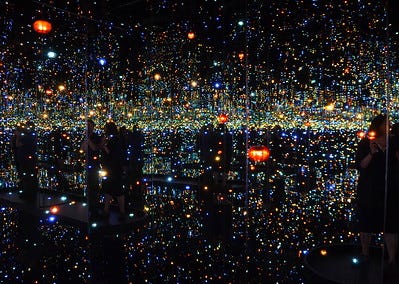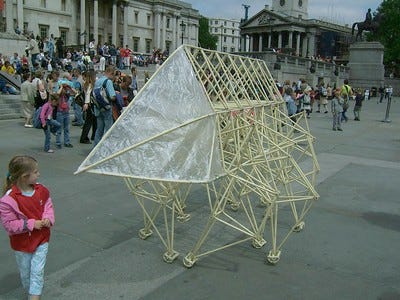3 Unconventional Art Forms (And How to Appreciate Them)
Filling space with creativity from unusual bards.
Welcome to an exploration of the vibrant and dynamic world of street art, kinetic art, and light installation art. These diverse forms of expression have transformed public spaces into open-air galleries, captivating passersby with their beauty and complexity.
Street Art

Often stigmatized as mere vandalism, street art has evolved over the years into a highly respected form of expression. This vibrant and dynamic art form bursts with creativity, using the urban landscape as its canvas. Street artists utilize a range of materials and techniques, bringing life and color to dull city walls, and often delivering powerful social or political messages.
Famous Street Artists
Banksy: An elusive figure in the street art scene, Banksy is a pseudonymous England-based artist whose works often feature distinctive stenciling techniques. His art, frequently laced with satirical and subversive messages, provokes conversation about political and social issues. From his iconic "Balloon Girl" to the impactful "Migrant Child," Banksy's creativity continues to challenge and intrigue viewers worldwide.
Shepard Fairey: Known best for his "Obey Giant" series and the iconic "Hope" poster for Barack Obama's 2008 presidential campaign, Shepard Fairey is an American artist who has bridged the gap between street art and mainstream recognition. His bold and compelling works, often rooted in activism and social justice, have made him a significant figure in the global street art scene.
To fully appreciate street art, it's important to understand its context. Pay attention not just to the artwork itself, but also to its location and the surrounding environment. Street art is often deliberately site-specific, deeply intertwined with the space it inhabits. Also, consider the artist's potential message or motivation: some artists use their work to highlight social issues or to challenge the status quo. Finally, remember that street art is transient by nature, its impermanence being a part of its beauty.
Light Installation

Light installations are a captivating form of art that uses light and shadow to create stunning visuals. Artists use a range of light sources, from LED lights to neon tubes, to create everything from small light sculptures to massive installations. These works mesmerize viewers with their intricate play of light and color, creating environments that seem otherworldly. The complexity and beauty of this art form lie in the artist's ability to manipulate light, creating depth, texture, and mood that is often transformative.
Famous Light Installation Artists
James Turrell - An American artist primarily concerned with light and space, Turrell's work can almost be described as 'architecture of light.' His installations, known as 'skyspaces,' are specially constructed chambers with an aperture in the ceiling open to the sky. Turrell's works are designed to create an experience of light divorced from the distractions of the outside world.
Olafur Eliasson - A Danish-Icelandic artist known for his large-scale installation art, Eliasson's work often involves elemental materials such as light, water, and air temperature to enhance the viewer's experience. One of his most famous installations, 'The Weather Project,' transformed the Tate Modern's Turbine Hall into a looming, sun-lit mist.
To truly appreciate light installations, it's vital to immerse yourself fully in the experience. These installations are designed to envelop the viewer in light and color, creating an immersive sensory experience. It's not just about looking at a piece from a distance, but stepping into it, letting the light wash over you, and observing how it shifts and changes as you move. Pay attention to how the artist uses light and shadow, how they work with space, and what feelings and thoughts the installation provoke in you. Remember, the beauty of light installations often lies in their ability to evoke emotion and create an atmosphere.
Kinetic Art

Kinetic art is a fascinating form of art that incorporates movement as a fundamental aspect of the artistic expression. Artists employ various elements such as wind, light, or motors to bring their creations to life, making the artwork dynamic and ever-changing. This art form ranges from delicate mobiles swaying in the air to large-scale installations where intricate mechanics interact in mesmerizing patterns. The power of kinetic art lies in its capacity to draw viewers into the artwork, creating a unique, interactive experience that is both engaging and thought-provoking.
Famous Kinetic Artists
Alexander Calder - Often referred to as the father of kinetic art, Alexander Calder was an American artist renowned for his mobiles - suspended, balanced sculptures that move with the air currents. His innovative work combined abstract shapes, colors, and real-life objects, transforming them into dynamic, moving sculptures. He makes movement and balance integral parts of his creations.
Jean Tinguely - Jean Tinguely was a Swiss artist known for his mechanically driven kinetic sculptures known as 'metamechanics'. His work often employed discarded materials and mechanical elements, creating intricate, machine-like contraptions that moved and interacted in complex ways. Tinguely's art was often filled with humor and satire, as he used his kinetic sculptures to critique the industrial society's obsession with progress and materialism.
Appreciating kinetic art requires an open mind and a willingness to engage with the artwork on multiple levels. Firstly, observe the movement and try to understand how it contributes to the overall expression of the piece. How does the motion influence your perception of the artwork? Secondly, consider the mechanisms that power the movement. The engineering behind the art is often as impressive as the visual effect it creates. Lastly, kinetic art is often meant to provoke thought and discussion, so reflect on the feelings and thoughts the movement incites within you. Remember, kinetic art is about more than just observing; it's about experiencing the art in motion and allowing it to stimulate your senses and intellect.
These art forms bring beauty to big spaces
Personally I find the creativity and imagination of these types of artists truly amazing. I have a local street artist who loves to paint over billboards, and sometimes they are really great. It’s not graffiti at all, even if it is in that style. And I wish I could see a kinetic sculpture by Theo Jansen live, and ask him about his crazy engineering process. (You can get models in his shop.) And while light sculptures aren’t my jive, they still require a tremendous depth of imagination and engineering to make them work. All truly great forms of art, all modern bards!
Share your thoughts!
I love when readers engage in the conversation. Do you have a favorite street art mural, kinetic installation, or light art spectacle? Leave a comment below or share this post with friends to spread the appreciation for these fascinating art forms. Let's foster a community where we can explore and discuss the beautiful diversity of art in our world. Your voice matters in this dialogue, and I can't wait to hear from you!


